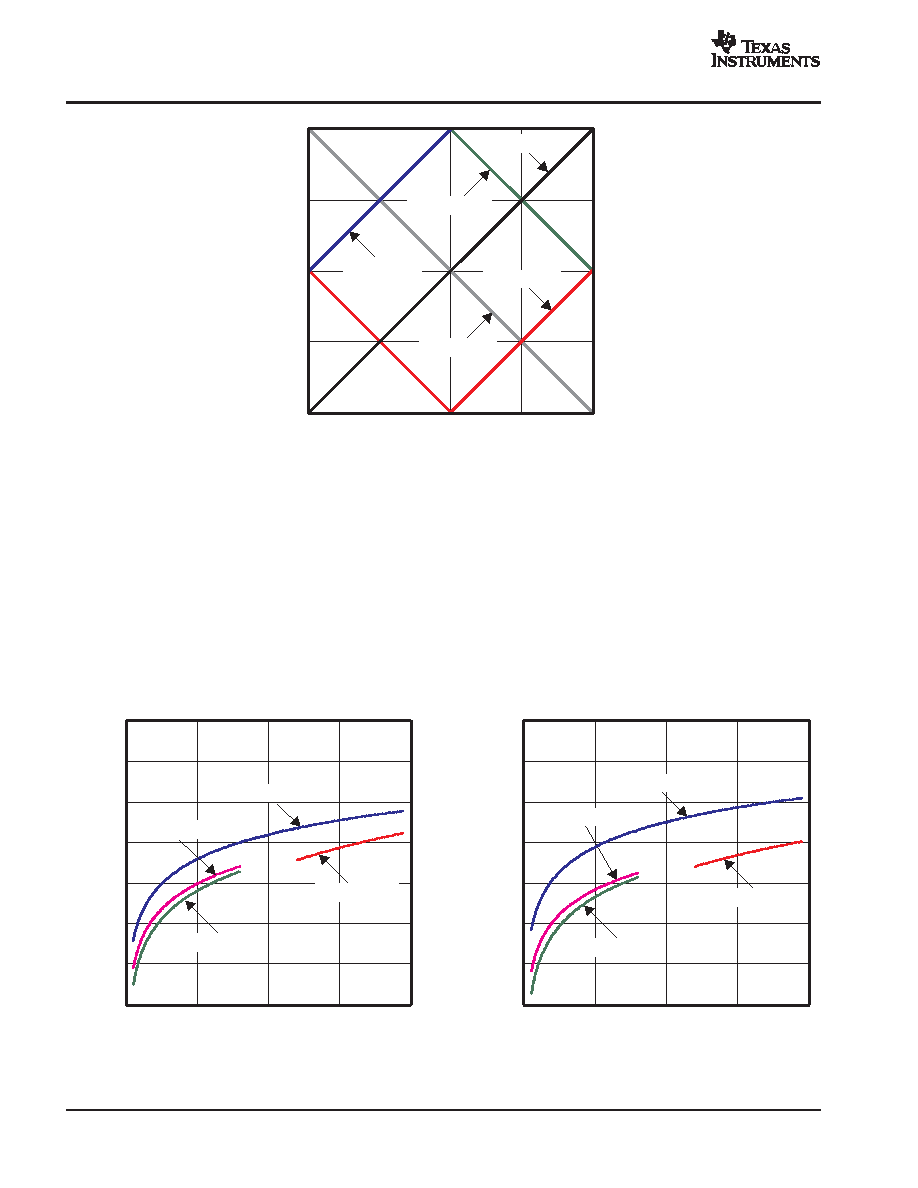- 您现在的位置:买卖IC网 > Sheet目录1992 > DAC5674IPHPG4 (Texas Instruments)IC DAC 14BIT 400MSPS 48-HTQFP

DAC5674
SLWS148A SEPTEMBER 2003 REVISED OCTOBER 2005
www.ti.com
22
Output Frequency / DAC Frequency
0.000
0.125
0.250
0.375
0.500
0.000
0.125
0.250
0.375
0.500
Spur
Frequency
/
DAC
Frequency
IF 3fDAC/4
IF fDAC/4
IF + fDAC/4
IF fDAC/2
Output IF
Figure 23. Location of Clock Mixing Spurs vs IF for 4
y Mode
The offset between wanted and spurious signals is maximized at low IFs (< fDAC/8) and at fDAC × 3/16,
fDAC
× 5/16, and fDAC × 7/16. For example, with fDATA = 100 MSPS and 4× interpolation, operating with
IF = fDAC × 5/16 = 125 MHz results in spurious signals at offsets of ±50 MHz from the wanted signal.
Figure 24a shows the amplitude of each spurious signal as a function of IF in external-clock mode. The
dominant spurious signal is IF fDAC/2. The amplitudes of the IF + fDAC/4 and IF fDAC/4 are the next-highest
spurious signals and are approximately at the same amplitude. Finally, at IF frequencies greater than 100 MHz,
small spurious signals at IF fDAC × 3/4 are measurable.
Figure 24b shows the amplitude of each spurious signal as a function of IF in PLL clock mode. Generating the
DAC clock with the onboard PLL/VCO increases the IF fDAC/2 by 3 dB. The amplitude of the IF ± fDAC/4 and
IF fDAC × 3/4 remain at about the same level as in the external-clock mode.
a. External Clock Mode
b. PLL Mode
70
60
50
40
30
20
10
0
50
100
150
200
fsig Output Frequency MHz
Amplitude
of
Spurs
dBc
IF FDAC/2
IF + FDAC/4
IF 3FDAC/4
IF FDAC/4
70
60
50
40
30
20
10
0
50
100
150
200
fsig Output Frequency MHz
Amplitude
of
Spurs
dBc
IF FDAC/2
IF + FDAC/4
IF 3FDAC/4
IF FDAC/4
Figure 24. External Clock Mode and PLL Mode
发布紧急采购,3分钟左右您将得到回复。
相关PDF资料
DAC7621EBG4
IC SNGL 12BIT PARALLEL D/A 20SSO
DAC7801KPG4
IC DUAL 12BIT CMOS DAC 24-DIP
DAC8043AESZ
IC DAC 12BIT MULT SRL INP 8SOIC
DAC8043GP
IC DAC 12BIT MULTIPLY CMOS 8-DIP
DAC8221GP
IC DAC 12BIT DUAL W/BUFF 24-DIP
DAC8222GPZ
IC DAC 12BIT DUAL W/BUFF 24DIP
DAC8229FSZ-REEL
IC DAC 8BIT DUAL V-OUT 20SOIC
DAC8248FS
IC DAC 12BIT DUAL W/BUFF 24-SOIC
相关代理商/技术参数
DAC5674IPHP-ND
制造商: 功能描述: 制造商:undefined 功能描述:
DAC5674IPHPR
功能描述:数模转换器- DAC 14-Bit 400 CommsDAC RoHS:否 制造商:Texas Instruments 转换器数量:1 DAC 输出端数量:1 转换速率:2 MSPs 分辨率:16 bit 接口类型:QSPI, SPI, Serial (3-Wire, Microwire) 稳定时间:1 us 最大工作温度:+ 85 C 安装风格:SMD/SMT 封装 / 箱体:SOIC-14 封装:Tube
DAC5674IPHPRG4
功能描述:数模转换器- DAC 14-Bit 400 CommsDAC RoHS:否 制造商:Texas Instruments 转换器数量:1 DAC 输出端数量:1 转换速率:2 MSPs 分辨率:16 bit 接口类型:QSPI, SPI, Serial (3-Wire, Microwire) 稳定时间:1 us 最大工作温度:+ 85 C 安装风格:SMD/SMT 封装 / 箱体:SOIC-14 封装:Tube
DAC5675
制造商:TI 制造商全称:Texas Instruments 功能描述:14-BIT, 400-MSPS DIGITAL-TO-ANALOG CONVERTER
DAC5675A
制造商:TI 制造商全称:Texas Instruments 功能描述:14-Bit, 400MSPS Digital-to-Analog Converter
DAC5675AEVM
功能描述:数据转换 IC 开发工具 DAC5675A Eval Mod RoHS:否 制造商:Texas Instruments 产品:Demonstration Kits 类型:ADC 工具用于评估:ADS130E08 接口类型:SPI 工作电源电压:- 6 V to + 6 V
DAC5675AIPHP
功能描述:数模转换器- DAC 14-Bit 400-MSPS RoHS:否 制造商:Texas Instruments 转换器数量:1 DAC 输出端数量:1 转换速率:2 MSPs 分辨率:16 bit 接口类型:QSPI, SPI, Serial (3-Wire, Microwire) 稳定时间:1 us 最大工作温度:+ 85 C 安装风格:SMD/SMT 封装 / 箱体:SOIC-14 封装:Tube
DAC5675AIPHP
制造商:Texas Instruments 功能描述:IC DAC 14BIT 400MSPS 48-HTQFP